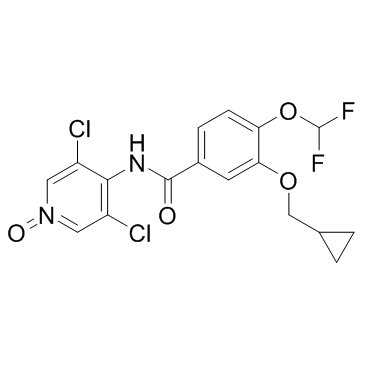Roflumilast N-oxide
Modify Date: 2024-01-02 18:13:30

Roflumilast N-oxide structure
|
Common Name | Roflumilast N-oxide | ||
|---|---|---|---|---|
| CAS Number | 292135-78-5 | Molecular Weight | 419.207 | |
| Density | 1.6±0.1 g/cm3 | Boiling Point | 519.7±50.0 °C at 760 mmHg | |
| Molecular Formula | C17H14Cl2F2N2O4 | Melting Point | 181 °C | |
| MSDS | N/A | Flash Point | 268.1±30.1 °C | |
Use of Roflumilast N-oxideRoflumilast N-oxide is a PDE type 4 inhibitor. |
| Name | 3-(cyclopropylmethoxy)-N-(3,5-dichloro-1-hydroxypyridin-4-ylidene)-4-(difluoromethoxy)benzamide |
|---|---|
| Synonym | More Synonyms |
| Description | Roflumilast N-oxide is a PDE type 4 inhibitor. |
|---|---|
| Related Catalog | |
| Target |
PDE type 4[1] |
| In Vitro | Roflumilast N-oxide at 2 nM partly mitigates the cigarette smoke extract (CSE)-induced epithelial to mesenchymal transition (EMT) in WD-HBEC in vitro. Roflumilast N-oxide (2 nM) reverses the compromised expression of E-cadherin transcripts following CSE by 45%. The expression of collagen type I is abrogated by Roflumilast N-oxide (2 nM). The epithelial cell phenotype appears protected when cells are co-incubated with Roflumilast N-oxide (2 nM). Pre-incubation with Roflumilast N-oxide (2 nM) also partly attenuates the nuclear translocation of β-catenin[2]. |
| In Vivo | Single treatment of db/db mice with 10 mg/kg Roflumilast N-oxide enhances plasma glucagon-like peptide-1 (GLP-1) 4-fold. Chronic treatment of db/db mice with Roflumilast N-oxide at 3 mg/kg shows prevention of disease progression. Roflumilast-N-oxide abolishes the increase in blood glucose, reduces the increment in HbA1c by 50% and doubles fasted serum insulin compare with vehicle, concomitants with preservation of pancreatic islet morphology. Furthermore, Roflumilast-N-oxide amplifies forskolin-induced insulin release in primary islets. Roflumilast-N-oxide also shows stronger glucose-lowering effects than its parent compound[3]. |
| Cell Assay | A549 cells are washed and cultured overnight in serum-free F-12 K medium supplemented with antibiotics, L-glutamine and HEPES. The starved cells are incubated with Neutrophil elastase (NE) for 30 min or vehicle (PBS), washed with PBS and then cultured in serum free F-12 K. After stimulation, cell supernatants are collected at 24 h (for cytokine measurements) and cell pellets are collected after 2 h (for mRNA expression analysis). Alternatively, A549 cells are pre-incubated for 2 h with Roflumilast N-oxide (RNO) (at 0.1 μM, 0.3 μM and 1 μM), vehicle (DMSO 0.01%) prior to the addition of NE. All experiments are performed in serum-free medium in triplicate and are repeated at least three times. At the end of the incubation period, culture supernatants are harvested and stored at -80°C until further analysis[1]. |
| Animal Admin | At 7 weeks of age, 16 h fasting mice receive a single oral dose of vehicle (4% methocel) or 10 mg/kg Roflumilast-N-oxide, and a glucose bolus of 2 g/kg body weight is co-administered as a physiological initiator for glucagon-like peptide-1 (GLP-1) secretion. Plasma GLP-1 is analyzed 60 min before, and 10 and 60 min after administration of Roflumilast-N-oxide and glucose. The effect of Roflumilast-N-oxide on plasma GLP-1 is also investigated in the absence of the glucose bolus[3]. |
| References |
| Density | 1.6±0.1 g/cm3 |
|---|---|
| Boiling Point | 519.7±50.0 °C at 760 mmHg |
| Melting Point | 181 °C |
| Molecular Formula | C17H14Cl2F2N2O4 |
| Molecular Weight | 419.207 |
| Flash Point | 268.1±30.1 °C |
| Exact Mass | 418.029877 |
| PSA | 73.05000 |
| LogP | 1.43 |
| Vapour Pressure | 0.0±1.4 mmHg at 25°C |
| Index of Refraction | 1.616 |
| 3-(Cyclopropylmethoxy)-N-(3,5-dichloro-1-oxido-4-pyridinyl)-4-(difluoromethoxy)benzamide |
| Roflumilast N-oxide |
| UNII-F08MQ6CZCS |
| Benzamide, 3-(cyclopropylmethoxy)-N-(3,5-dichloro-1-oxido-4-pyridinyl)-4-(difluoromethoxy)- |
| Roflumilast Impurity 6 |